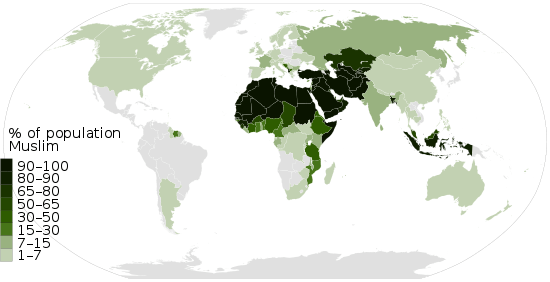Islam in Madagascar
Islam has been well established in what is now known as Madagascar for centuries and today Muslims represent 7% of the population.[1] The vast majority of Muslims in Madagascar practice Sunni Islam of the Shafi school of jurisprudence.
_W.M._Sonny_Dinkins_talks_with_leaders_of_the_Islamic_Grand_Mosque_in_Antananarivo_during_a_trip_to_meet_area_religious_leaders.jpg)
Historical Background
Settlement of Arabs
Beginning in the 10th or 11th century, Arab, Somali, and Zanzibari ivory merchants worked their way down the east coast of Africa in their dhows and established settlements on the west coast of Madagascar. The most noteworthy of these were the Zafiraminia, traditional ancestors of the Antemoro, Antanosy and other east coast ethnicities. The last wave of Arab immigrants would be the Antalaotra who immigrated from eastern African colonies. They settled the north-west of the island (Majunga area) and were the first to actually bring Islam to the island.
Arab and Somali Muslim immigrants were few in total number compared to the Indonesians and Bantus, but they left a lasting impression. The Malagasy names for seasons, months, days, and coins are Islamic in origin, as is the practice of circumcision, the communal grain pool, and different forms of salutation. The Arab magicians, known as the ombiasy, established themselves in the courts of many Malagasy tribal kingdoms. The Arab-Somali immigrants brought their patriarchal system of family and clan of non Islamic civilization rule to Madagascar, which differed from the Polynesian matriarchal system whereby rights of privilege and property are conferred equally on men and women. Sorabe is an alphabet based on Arabic used to transcribe the Malagasy language and the Antemoro dialect in particular. The Arabs were also the first to correctly identify the origin of most Malagasy by suggesting that the island was colonized by the Indonesians.[2]
Colonization and Independence
Upon independence from France in 1960, Madagascar began developing close ties with staunchly secular power the Soviet Union. This stifled the development of all religion in Madagascar. However, in the 1980s, Madagascar drifted away from the Soviet Union and back towards France.
Followers constitute approximately 7% of the population, according to the US Department of State in 2011,[3] (Down from their earlier estimate of 10 to 15% in 2009[4]), or 3% according to the Pew Research Center in 2010.[5]
See also
References
- The World Factbook - Madagascar
- Informed Comment
- Bureau of African Affairs (3 May 2011). "Background Note: Madagascar". U.S. Department of State. Retrieved 24 August 2011.
- "Madagascar". US Department of State. 2009. Archived from the original on 2009-11-30.
